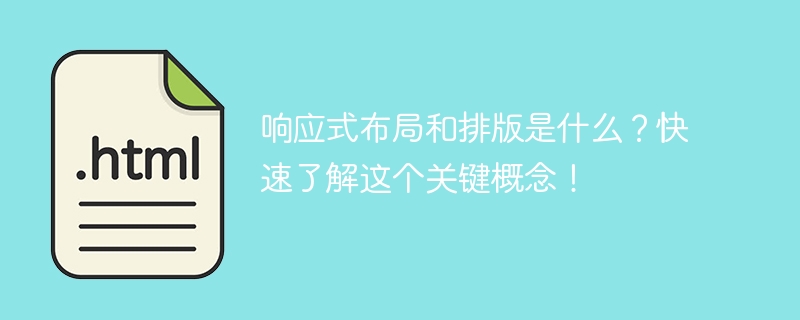

Responsive layout and typography refers to the automatic adjustment of the layout and typography style of web pages according to changes in different devices and screen sizes in web design. The development of this technology enables web pages to display content in the best possible way on various devices, providing a good user experience whether on a computer, tablet or mobile phone.
In the past, web design was often done based on fixed sizes and layouts. This means that no matter what device the user uses to access the web page, the layout and typography of the web page will be the same. However, with the popularity and diversification of mobile devices, users' demand for accessing web pages on mobile phones continues to increase. However, the size of mobile phone screens and computer screens are very different, so the traditional fixed layout can no longer meet the needs of users.
In order to solve this problem, responsive layout and typesetting technology came into being. The core idea of responsive layout is to use elastic layout, media queries and other related technologies to enable web pages to automatically adjust the layout according to the user's device size to adapt to different screen sizes. Responsive typography refers to adjusting the text, font size, line spacing and other layout styles of the web page according to changes in different screen sizes and device orientations to ensure the readability and beauty of the text content.
In order to achieve responsive layout and typography, front-end developers need to use technologies such as HTML, CSS, and JavaScript. Among them, HTML is used to define the structure and content of web pages, CSS is used to control the style of web pages, and JavaScript is used to achieve some interactive and dynamic effects. By using media queries, developers can apply different CSS styles based on screen size and other conditions to achieve adaptive layout and typography of web pages.
The advantage of responsive layout and typography is not only to provide a good user experience, but also to save development and maintenance costs. Since only one web page version needs to be developed instead of multiple versions specifically adapted to different devices, development time and resource investment can be reduced. At the same time, because of the use of adaptive layout and typesetting, web pages can automatically adapt to the emergence of various new devices and screen sizes in the future without additional adaptation work.
However, responsive layout and typography also face some challenges. Since it is necessary to adapt to multiple screen sizes and device types, the characteristics and limitations of different devices, as well as the differences in user habits, need to be taken into account, so the workload of development and testing is relatively large. In addition, for complex web pages, the implementation of responsive layout and typography may be difficult and require careful planning and design.
In general, responsive layout and typography are important concepts in modern web design, which can provide a better user experience and adapt to different devices and screen sizes. With the popularity of mobile devices and the continuous advancement of technology, responsive layout and typography will become essential skills in web design. For developers, learning and mastering this technology will help enhance their professional competitiveness. At the same time, it is also a benefit for users to enjoy a better web experience.
The above is the detailed content of Quickly understand what responsive layout and typography are. For more information, please follow other related articles on the PHP Chinese website!
 How to restore videos that have been officially removed from Douyin
How to restore videos that have been officially removed from Douyin
 js method to generate random numbers
js method to generate random numbers
 How high will Ethereum go?
How high will Ethereum go?
 How to recover deleted files on computer
How to recover deleted files on computer
 How many years do you have to pay for medical insurance to enjoy lifelong medical insurance?
How many years do you have to pay for medical insurance to enjoy lifelong medical insurance?
 What to do if there is no cursor when clicking on the input box
What to do if there is no cursor when clicking on the input box
 What should I do if English letters appear when I turn on the computer and the computer cannot be turned on?
What should I do if English letters appear when I turn on the computer and the computer cannot be turned on?
 How to create virtual wifi in win7
How to create virtual wifi in win7




